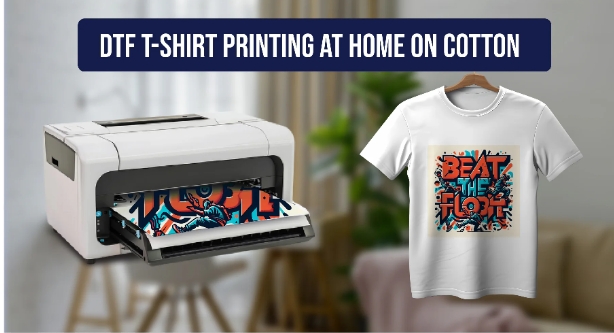
Think about a custom t-shirt that you bought the last time.
Did it have a bold graphic, a quirky slogan, or a design that just felt unique? That's the art of customization; it gives a personal feel. You know that one of the trending printing methods is Direct to Film (DTF) printing.
This method produces long-lasting prints that can be pasted on almost any fabric. Do you wish to try this method as a DIYer or a businessman?
With the help of this guide, let’s know what DTF printing is, how it works, its pros and cons, and how it’s better than older techniques like screen printing. You can, therefore, make a decision whether it is an apt choice in your business or your next DIY job.
DTF printing is a creative method of printing on clothes. In this process, first, the design is printed on a special film, and then, using a heat press machine, it is transferred to the cloth.
It is an increasingly popular choice with new and smaller business owners as it does not require pre-treating fabrics or creating messy work stations like other older printing methods, like the DTG printer (Direct-to-Garment).
The DTF printing is a simple process, but it requires precision and appropriate materials. Here’s a step-by-step look:
You can design using graphic design software like Adobe Illustrator, Photoshop, or CorelDRAW. Save it to a compatible format such as PNG with a transparent background.
Load the design into the DTF printer. The printer uses special inks (including white) to print your design onto a PET film. White ink is printed last to act as a base layer.
After the design is printed, apply DTF adhesive powder evenly over the design while the ink is still wet. Shake off the excess powder.
Place the printed film in a curing oven or under a heat press (without pressure) to melt the powder. This step bonds the powder to the ink.
Set the cured film onto the fabric (e.g., a t-shirt), and press it using a DTF printing heat press at around 160-170°C for 15-20 seconds.
Once pressed, let it cool for a few seconds, then cold peel the film to reveal your design on the fabric.
For durability, do a quick second press with a Teflon sheet for another 10 seconds. This step improves washability and finish.
DTF shirt printing offers multiple advantages, especially for small businesses and DIY enthusiasts:
Many screen printers are switching or adding DTF to their offerings. Here’s a quick comparison:
| Feature | DTF Printing | Screen Printing |
| Setup Time | Low | High (needs screens, inks, cleanup) |
| Small Orders | Ideal | Less efficient |
| Fabric Types | Works on most fabrics | Best on cotton |
| Print Detail | High (photo-quality) | Medium to high |
| Cost | Affordable for small runs | Cheaper for bulk |
If you’re running a custom t-shirt shop or working on short-run designs, DTF printing could be a great addition to your toolkit.
If you're already in the screen printing business, DTF can expand your capabilities without replacing what works. You can offer:
It’s also a fantastic way for beginners to break into the world of custom apparel printing without heavy investments.
If you’re new to DTF printing, here are some tips to help you get the best results right from the start:
DTF printing is centred around your printer and heat press. A good quality, dependable machine will give you consistent professional results.
The quality of your transfer film and adhesive powder can have a huge impact on the result of your final print appearance. Inexpensive materials can be cost-effective; however, they often lead to faded colors, peeling designs, or uneven transfers.
As you practice, DTF shirt printing gets better, like any other skill. You must start with test prints to get familiar with your machine settings, film handling, and heat press timing before working on real orders.
You must cure the adhesive powder in a well-ventilated place. This is required to prevent fume exposure or make your printing setup safe and comfortable.
The custom apparel industry is seeing higher demand, which also necessitates that the products deliver satisfying results. DTF printing produces the desired outcomes that can diversify your business or help you as a learner by using techniques that won’t demotivate you.
So, next time someone asks, "What is DTF printing?", you’ll not only know the answer but maybe even show them your own beautifully printed shirt.

This post has been authored and published by one of our premium contributors, who are experts in their fields. They bring high-quality, well-researched content that adds significant value to our platform.
